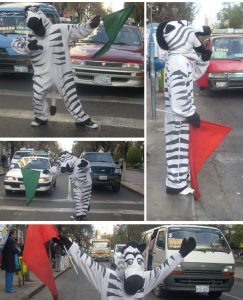Persuasion, Traffic, and Zebras
Let’s say that you’re the mayor of a big city that’s growing rapidly. Traffic jams last the entire day. Tempers fray and drivers become more and more aggressive. People ignore traffic laws. Pedestrians cross the streets whenever and wherever. Accidents happen constantly. Police can’t keep track of the chaos.
You’ve tried cracking down with more police writing more traffic tickets. That only makes the drivers angrier. Traffic is constantly tangled. The air is increasingly polluted. Your popularity is plummeting. You need a persuasion strategy to convince drivers to play fair and obey the rules. What to do?
How about putting some zebras in the streets? That’s what the mayor of La Paz, Bolivia did. Here’s how the magazine Veinte Mundos described the situation:
“Vehicular and pedestrian traffic is increasing every day in the Bolivian capital. Automobiles don’t respect the traffic signals and pedestrians cross the street wherever they want. It’s total chaos. People’s lives – especially children’s lives – are in constant danger. As a result, local authorities decided to take concrete steps to improve the situation. Thus were born the ‘zebras.'”
Each day in La Paz, roughly 400 to 500 young people dressed in zebra costumes disperse through the city to guide and direct traffic. But they’re not traffic cops. They’re not there to enforce the rules. They’re behavior modifiers. Ultimately, they hope to persuade people to behave – and drive — better.
The zebras dance and chatter and interact with both pedestrians and drivers. They remind people to mind the traffic lights, buckle up, cross with the light, and generally behave like good citizens. They reward good behavior with a dance, a pat on the back, and some kind words. They make fun of bad behavior by miming “Can you believe that? WTF?”
According to El País, the zebra program began in 2001 and quickly captured the attention of Kathia Salazar, a popular local actress. Salazar volunteered to run the program and soon became known as mamá cebra. Salazar says that the program started slowly: “When we first began, people yelled at the zebras, cursed them, and even tried to run them over. Slowly, things changed. Today, pedestrians are the ones who are protecting the zebras.”
The zebra program is sufficiently popular that it is now spreading to other cities, like Tarija, Sucre, and El Alto. It’s also expanding into new services. Zebras are now visiting schools and retirement homes. Their message has expanded, too. It’s not just about traffic. More generally, it’s about good citizenship and a positive attitude. As Amanda Pinos, a 29-year-old zebra puts it: “Our principal task as urban educators is to ask citizens to reflect on their own behavior and create a kinder, more respectful attitude.”
A similar program in Bogotá, Colombia inspired the zebra program in La Paz. The Bogotá program, which used mimes rather than zebras, began in the early 1990s and claimed to have reduced traffic fatalities by as much as 50%. I haven’t seen similar statistics for La Paz but it’s a fair bet that the zebras have calmed and smoothed and enhanced traffic in a traditionally tumultuous city. Think about it. Wouldn’t you drive more safely if zebras were around?
